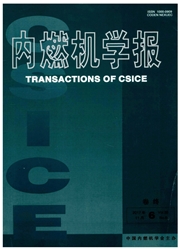

 中文摘要:
中文摘要:
以发动机前端附件驱动系统中两相邻轮之间的带为研究对象,将带简化成纵向运动的黏弹性弦,建立了带横向振动计算的模型。在带的模型中,运用Standard黏弹性模型表征其应力一应变关系。将带离散成为一系列的微段,使带横向振动的动力学方程和描述带应力一应变关系的本构方程离散为对时间的常微分方程;运用Runge—Kutta法求解带横向振动的位移。试验测试了某一发动机前端附件驱动系统中带的横向振动位移,将实测值与考虑或不考虑带的黏性时带的横向振动位移的计算值进行了对比分析,结果表明:考虑黏性时带横向振动位移的计算值与实测值吻合较好,从而验证了所建立的带的黏弹性弦模型和横向振动计算方法的正确性。分析了带的黏弹性参数(弹性模量和黏性系数)对发动机前端附件驱动系统带横向振动的影响,结果表明:带黏弹性参数对带横向振动的影响较大,带横向振动位移随着带的弹性模量与黏性系数的增大而减小。
 英文摘要:
英文摘要:
Simplified the belt between two adjacent pulleys in engine Front End Accessory Drive System(FEADS) as an axially moving visco-elastic string and characterized the relation of belt stress and strain with standard visco-elastic constitutive model, the belt transverse vibration equation was established usingHamilton's principle. Since the vibration equation and standard visco-elastic constitutive model were functions of time and belt location variables, the belt was discretized into a number of small belt sections, thus the equations for each belt section and the constitutive model became functions of time only. The transverse vibration displacement was found using Runge-Kutta method. The calculated belt transverse displacement data with and without considering belt viscosity were compared with the measured in a practical engine. Results show that the transverse vibration displacement data calculated considering belt viscosity agree better with the obtained from experiments, thus validating above model and calculation method presented in this paper. Based on the model, the influences of belt visco-elastic performances (longitudinal elastic modulus and viscous damping) on its transverse vibration are investigated. It is concluded that belt transverse vibration is influenced notably by the longitudinal elastic modulus and viscous damping and its displacement decreases with their increase.
 同期刊论文项目
同期刊论文项目
 同项目期刊论文
同项目期刊论文
 An improved pendulum method for the determination of the center of gravity and inertia tensor for ir
An improved pendulum method for the determination of the center of gravity and inertia tensor for ir Robust optimization design method for powertrain mounting systems based on six sigma quality control
Robust optimization design method for powertrain mounting systems based on six sigma quality control Tensioner Vibration and Belt Slipping Behavior Investigation for Damped Serpentine BeltDrive Systems
Tensioner Vibration and Belt Slipping Behavior Investigation for Damped Serpentine BeltDrive Systems Modeling and Validation of Rotational Vibration Responses for Accessory Drive Systems-Part I: Experi
Modeling and Validation of Rotational Vibration Responses for Accessory Drive Systems-Part I: Experi Modeling and Validation of Rotational Vibration Responses for Accessory Drive System-Part II: Simula
Modeling and Validation of Rotational Vibration Responses for Accessory Drive System-Part II: Simula 期刊信息
期刊信息
